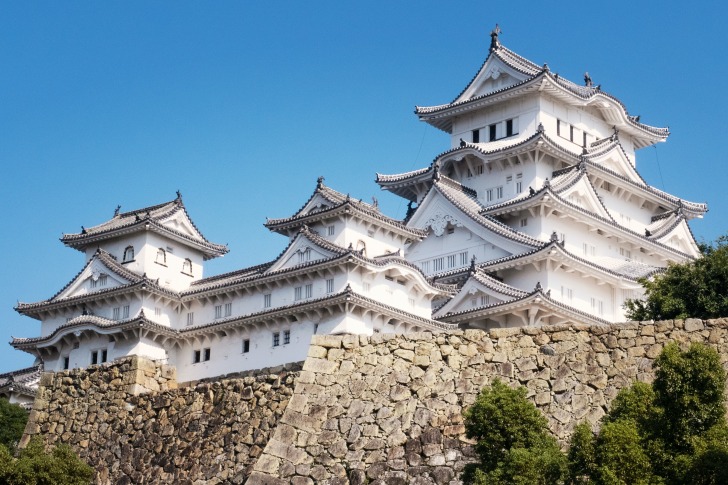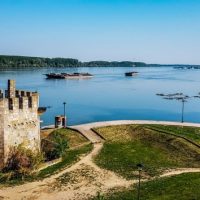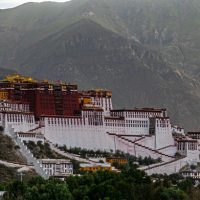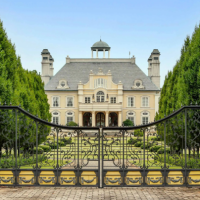For almost 600 years, Japan didn’t waste time building amazing castles.
At the peak of castle architecture, there were as many as 5,000 castles in existence at the same time.
Today, there are only 100 still standing.
While it may be hard to fathom what happened to all those structures, the world was left with some great buildings to visit.
Now let’s start a tour around the country to view the top 10 most impressive castles in Japan.
10 Most Beautiful Castles in Japan
1. Himeji Castle
The largest and one of the most visited castles in all of Japan was built over 13 years.
First, it was a fort commissioned by a samurai named Akamatsu Norimura.
It was later turned into a castle in the 1340s. Himeji Castle sits overlooking the city it was named after.
That wasn’t the last remodel.
It would go through several more with extra additions to the overall building each time.
The castle is regarded as the best example of prototypical Japanese architecture.
Feudal defensive systems are still in place, along with 83 rooms.
Himeji is also called the White Heron Castle because of the bright white exterior and lofty position similar to a bird taking off.
Himeji Castle was one of the first UNESCO World Heritage Sites in Japan.
That led to another restoration years later that brought the structure back to its original colors.
2. Osaka Castle
Osaka Castle is more than a castle, it’s a place of unification.
At least it was in the Azuchi-Momoyama period of the late 1500s.
Over the next almost 400 years, Osaka went through a repeated pattern of destruction and rebuilding.
By the time WWII came around, the castle was partly an arsenal.
A majority of the castle was blown apart by American bombs that killed almost 400 workers.
50 years later, a final restoration began.
As of today, Osaka Castle is a reproduction of what once was and is essentially a living museum.
A lot has changed in the area where the castle was built.
Today, over two and a half million people call Osaka home.
The 450-year-old castle has a modern downtown area with a handful of skyscrapers in the background.
The white and green castle still stands out as a testament to the past.
3. Nagoya Castle
Brought into fruition by a shogun named Tokugawa Ieyasu, Nagoya Castle was opened in 1615.
The design is notable for those interested in Japanese architecture because of the two-building setup.
There’s the main building, which has five levels, that is connected to a smaller building.
History lovers might be interested to know that this is where the most well-known warrior of his day, Oda Nobunaga, spent his childhood.
As stated, this is unlike other Japanese castles because of the connected two-story building.
That alone makes it easier to identify. Nagoya Castle’s main building stands out brilliantly over the trees.
From a distance, it almost looks like the castle is floating near the city.
Open almost every day for visitors, tours of Nagoya Castle are free.
4. Inuyama Castle
Looking out at Kiso River is a castle built in the mid-15th century and is believed to be the oldest tenshu architectural type in Japan.
It took almost 200 years to finish Inuyama Castle.
Much of the latter work was done by the son of Oda Nobunaga, Oda Nobukatsu.
For 12 generations, Inuyama Castle was lived in and owned by the Naruse clan.
In the early 00s, the clan saw fit to sign it over to the city government.
A foundation was created to make sure such an important landmark never falls into ruins.
With trees all around, Inuyama would blend in easily with the night, like a ninja.
Much of the castle is black with white walls. Inside, the walls and floor are bare in the traditional Japanese style.
5. Uwajima Castle
Uwajima Castle, also known as Tsurushima-jo, is one of the 12 remaining castles to have a well-preserved tenshu.
This National Historic Site took five years to construct and was completed in 1601.
Believe it or not, the castle used to sit on the beach.
The ocean was a natural barrier that could be used for a moat.
Later on, a plan went into action where new land was created from the ocean.
Uwajima didn’t have city buildings up against it and instead remains nestled in nature.
There is a solid rock foundation that leads up to the castle steps.
The stone sort of works like a platform where Uwajima is singled out amongst the trees.
Aside from touring the castle, a ticket includes a folklore museum.
6. Kochi Castle
The only castle in the country to have both the original tenshu and a palace, as well as all of the buildings first erected with it, is Kochi Castle.
That fact would make the first owner, Yamanouchi Kazutoyo, proud.
This wasn’t his first experience with a castle, so when he was stationed in the area, he had a vision in mind.
Over a century later, much of the master plan turned to ash after a fire.
The main building was part of the rebuild in 1748.
You can get a feel for the time period as you walk by the fortified stone walls leading up to Kochi Castle.
The charcoal roofs seem to shimmer in the sun.
That effect continues inside with shiny wood floors.
Kochi Castle Park is a place you can spend a whole day, many times over.
7. Nijo Castle
Nijo Castle is a UNESCO World Heritage Site built in 1603.
Immediately at the gate, you get a sense of the powerful force that wanted this castle to come alive.
Shogun had a way of showing off and there’s nothing like gold on black to give a serious impression.
Tokugawa Ieyasu was the particular shogun here and he was the first of the branch in his name that was the go-to warlord of Japan for two centuries.
This castle is wooden, more Zen-like than other locations thanks to the immersive gardens.
The detail was clearly thought out and done right since it’s still here after all these years.
8. Maruoka Castle
They say whenever an enemy approaches, a mist so thick you could cut it with a knife must cloak the castle.
At least that’s where the nickname Kasumi-ga-jo comes from.
Officially ready for tenants as far back as the late 16th century, Maruoka Castle was built by Shibata Katsutoyo, the nephew of Oda Nobunaga’s top general.
Over the years, 17 lords called Maruoka home.
Currently, this castle was saved from dilapidation by the government turning it and the land into a park.
Tourists come from all over to admire the cherry blossoms.
If you want to visit, be prepared for a hike.
There is a litany of steep steps up to the door.
9. Shimabara Castle
The stark white of this castle is enough to catch your eye, but the five stories help, too.
Completed in 1618, Shimabara Castle was the dream child of the Arima clan.
They probably used this structure to intimidate the local peasants.
Any help they could get would have been welcomed after having raised the taxes so high it was almost impossible to live.
Unsurprisingly, there was a rebellion to follow.
Luckily for history buffs, the castle was not messed with.
Because of that, some of the original structure still exists.
10. Matsue Castle
Matsue Castle wasn’t there to protect the people; it was there to be part of the battle.
It also came dressed in all black, incognito to enemies.
The walls are deep in stone and ready for an ambush.
While it was put in place for war, the castle didn’t end up seeing much in the way of battle.
The Edo period was full of fighting and a large reason why similar fortresses were popping up all over Japan.
It just so happened that Horio Yoshiharu had the right idea a bit too late.
The period was winding down by the time Matsue was completed in the early part of the 1600s.
Horio didn’t know he was doing us such a favor by that judgment call.
He accidentally gave the future a gift from the past.
Japan Safety Overview
READ THE FULL REPORT: Japan Safety Review
Safety Index: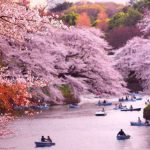
- OVERALL RISK: LOW
- TRANSPORT & TAXIS RISK: LOW
- PICKPOCKETS RISK: LOW
- NATURAL DISASTERS RISK: MEDIUM
- MUGGING RISK: LOW
- TERRORISM RISK: LOW
- SCAMS RISK: LOW
- WOMEN TRAVELERS RISK: LOW
Frequently Asked Questions
What's the oldest castle in Japan?
Inuyama Castle dates back to the mid-15th century.
Unfortunately, due to damage, there was a major reconstruction 100 years later and that final product is what we are able to see today.
The work done on this castle is well known for having been done during the Momoyama Period.
Inuyama is the best-standing example in Japan today of defensive architecture.
Who lived in Japanese castles?
Back in the day, anyone with means that needed defending would hole up in a castle.
Although a vast majority of people did not, the typical resident is probably who you would imagine.
Feudal lords and samurai commonly called castles their homes.
Of course, the imperial family called more than one castle their home, too.
Today, the royals live in a palace, and owning a castle is something the government does.
When were there 5,000 castles in Japan?
Between the mid-1400s through the early 1600s, castles were being built at a swift rate all across Japan.
That’s because this era was called the Warring States.
Too many leaders were at each other’s throats.
The most standing at one point in time would be from this time frame after this time before they were destroyed, repurposed, or saved for the future.
What's the most popular castle in Japan?
The stonewall foundation of Osaka Castle is both quintessential Japanese architecture and one of the most famous places in the country.
Almost three million people walk through the site each year.
Osaka Castle is one of the highest-rated places to visit as well.
Many often comment that if you see nothing else in Japan, let this be it.
